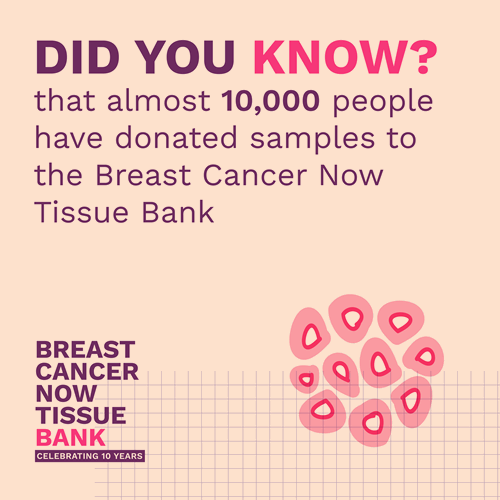
Breast Cancer Now’s Tissue Bank is celebrating 10 years of ground-breaking global research! Walk the Walk is delighted to have been a founding funder of this amazing resource, alongside Asda Tickled Pink.
The Tissue Bank opened in 2012, to give researchers access to high-quality breast tissue, breast cells and blood samples from breast cancer patients. Over its first decade, the bank has helped accelerate progress towards faster diagnosis and better treatments.
Researchers from across the globe can apply to access samples and the Tissue Bank has supported research teams in 12 countries, including the UK, Taiwan, USA, Italy, Finland, Sweden, South Korea, Portugal, Norway, Spain, Switzerland and Germany.
Professor Louise Jones, Co-principal Investigator of the Breast Cancer Now Tissue Bank and Professor of Breast Pathology at Barts Cancer Institute, Queen Mary University of London, said:
“Access to high-quality, large-scale collections of tissue samples is very important for researchers to be able to translate their findings from laboratory bench to hospital bedside. On the 10th anniversary of the Breast Cancer Now Tissue Bank, we’re celebrating the fact we have collected samples from nearly 10,000 patients bringing our collection to 126,000 samples. This huge achievement is underpinning research across the world.
“The projects the Tissue Bank supports are phenomenal and I’m confident they will continue to help provide new breakthroughs for women and men diagnosed with breast cancer.”
The Tissue Bank was founded following a wide-scale review by leading scientists. They discovered that one of the greatest challenges faced by breast cancer research was the lack of access to high-quality tissue to study and better understand the disease.
Today, the Tissue Bank sits across four sites at Barts Cancer Institute, Queen Mary University of London (lead operational centre), the University of Aberdeen, the University of East Anglia in Norwich, and the University of Sheffield.

Brenda Barnett, 64, from Aberdeen was diagnosed with stage 2 invasive ductal carcinoma plus DCIS in January 2020 and was asked to donate tissue samples to research following her lumpectomy surgery. Brenda said:
“I was a grandmother of four when I was diagnosed with breast cancer, and thanks to research I lived to see the birth of my fifth grandchild. Getting a breast cancer diagnosis is life-changing, but I was lucky. They caught my cancer early and treated it quickly so now I have the privilege of watching all five grandchildren grow up together.
“That’s why choosing to donate my tissue samples for research was a no-brainer, even when I didn’t know what was going to happen to me. If it could help other people in the future, it was worth it.
“The work they do at the Breast Cancer Now Tissue Bank is vital and will change lives for generations to come. I’m proud to say I’ve contributed to future discoveries in some small way.”

Sue Stannard, 69, from Caythorpe was diagnosed with oestrogen positive and HER2 positive breast cancer in 2011 and became one of the first people to donate to the Tissue Bank following mastectomy surgery. She said:
“I remember I was sitting in these disposable hospital knickers and gown with black ink all over my chest from the surgeon’s preparations for my mastectomy and a white beanie hat covering my bald head - a fairly low point for me emotionally. A woman then came in with some forms and spoke to me about the hospital collecting tissue for breast cancer research. I don't recall what she said other than asking if it was something I would be willing to consent to, but I didn’t have to give it a second thought.
“I signed a form and that was it. I didn’t know at the time it was a new tissue bank, but I understood the importance of research. Every little step is so significant. If having real human tissue can help speed up the development of other new treatments, then there’s really no decision to make - it’s so obviously a positive thing to do and it’s not as if I needed the tissue for anything else!
“Having treatment options is everything when you’re going through breast cancer. If I am unlucky and it does come back, I will rely on having those options again, and I know that’s only possible through research.”

Of the 12,000 samples allocated to research, some of the key findings include:
- Scientists from Queen Mary University of London and the Francis Crick Institute used samples from the Breast Cancer Now Tissue Bank to better understand how obesity can contribute to the development of breast cancer at a molecular level. This helped them to identify a treatment that may reduce the risk of people developing breast cancer linked with obesity.
- Samples from the Tissue Bank have contributed to research at the University of York, which found a protein on cancer cells that may help breast cancer spread around the body. Researchers think this finding could eventually lead to a diagnostic tool for breast cancer.
- Researchers at the Barts Cancer Institute, Queen Mary University of London, used healthy cells donated to the Tissue Bank to recreate a structure closely resembling breast ducts in the lab. The researchers are now using this 3D model to study an early form of breast cancer.
The Breast Cancer Now Tissue Bank is run thanks to donations made by its supporters, as well as by funding from Asda Tickled Pink and the Garfield Weston Foundation.
Thank you to our amazing Walk the Walkers for helping to make this incredible project happen! Read more about Walk the Walk’s other key grants for research.









Comments